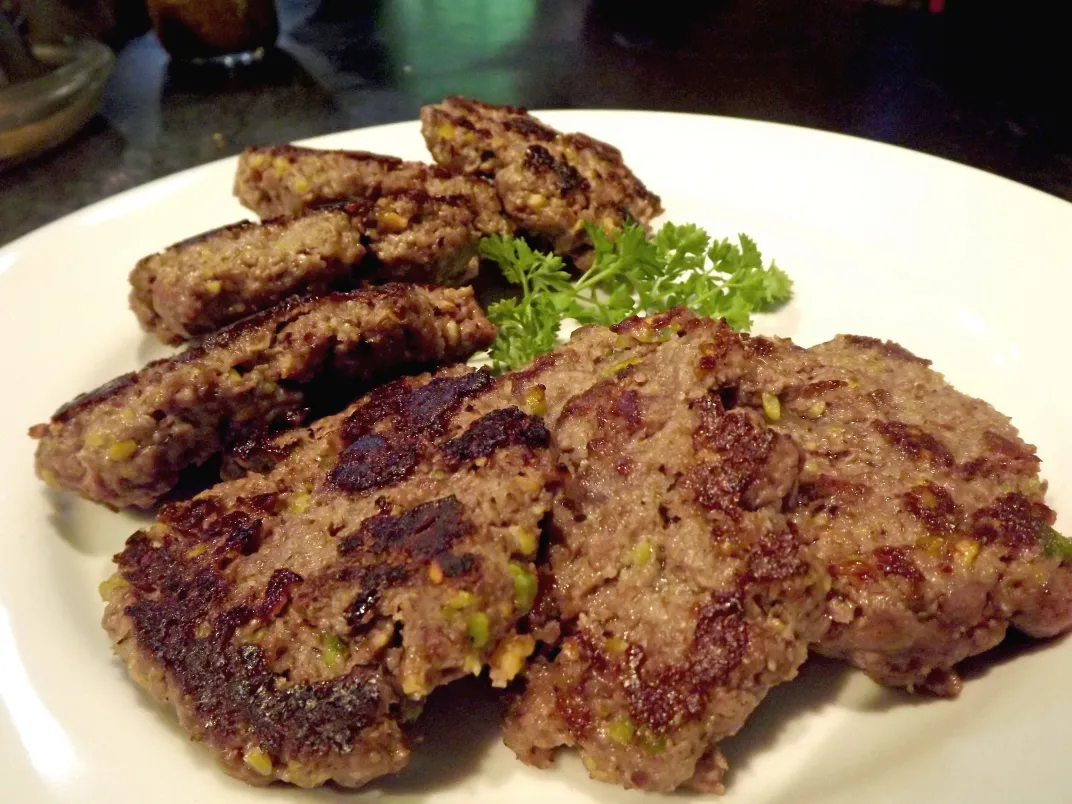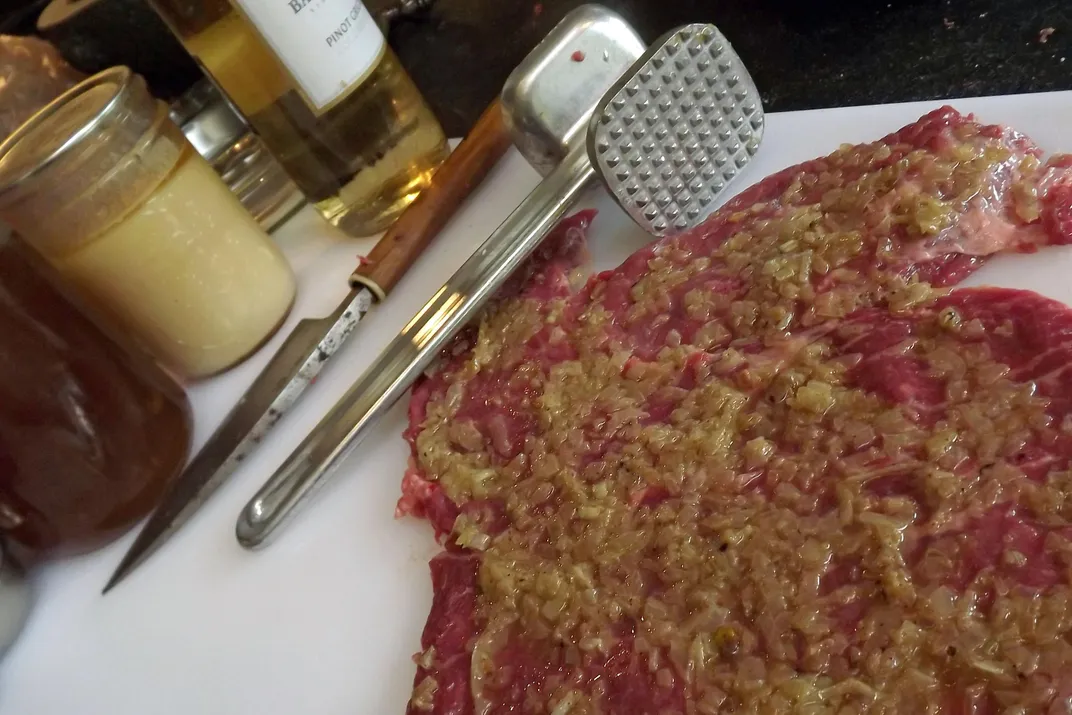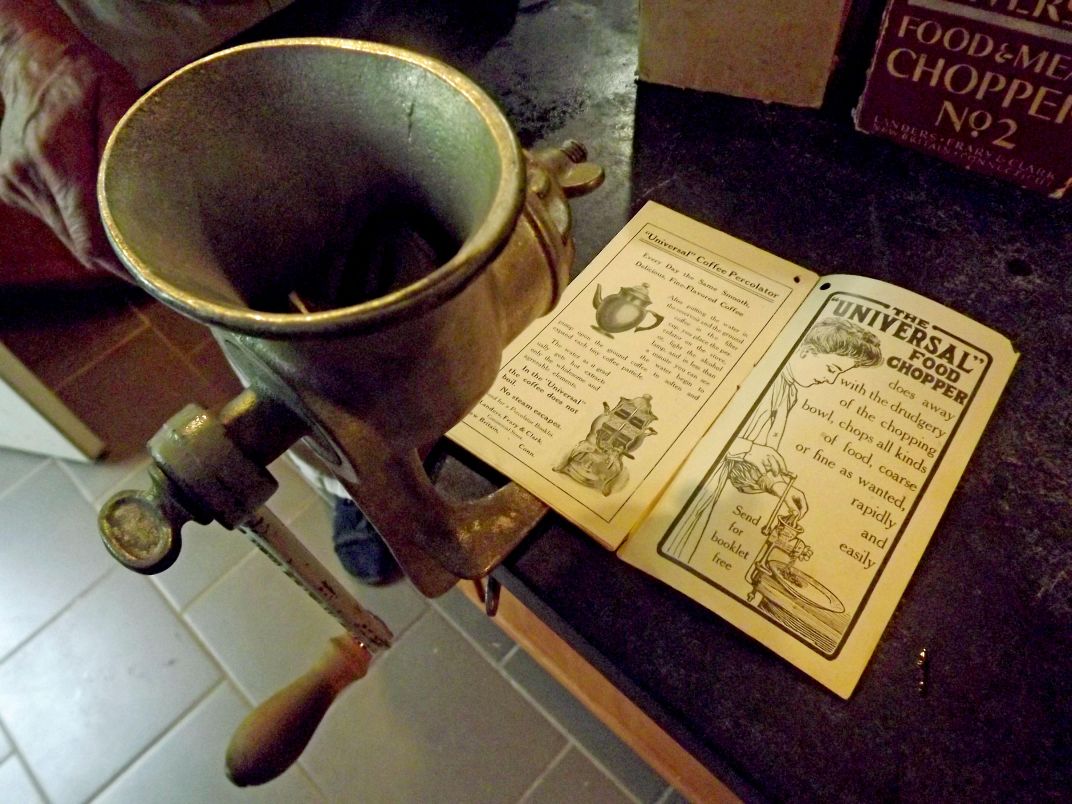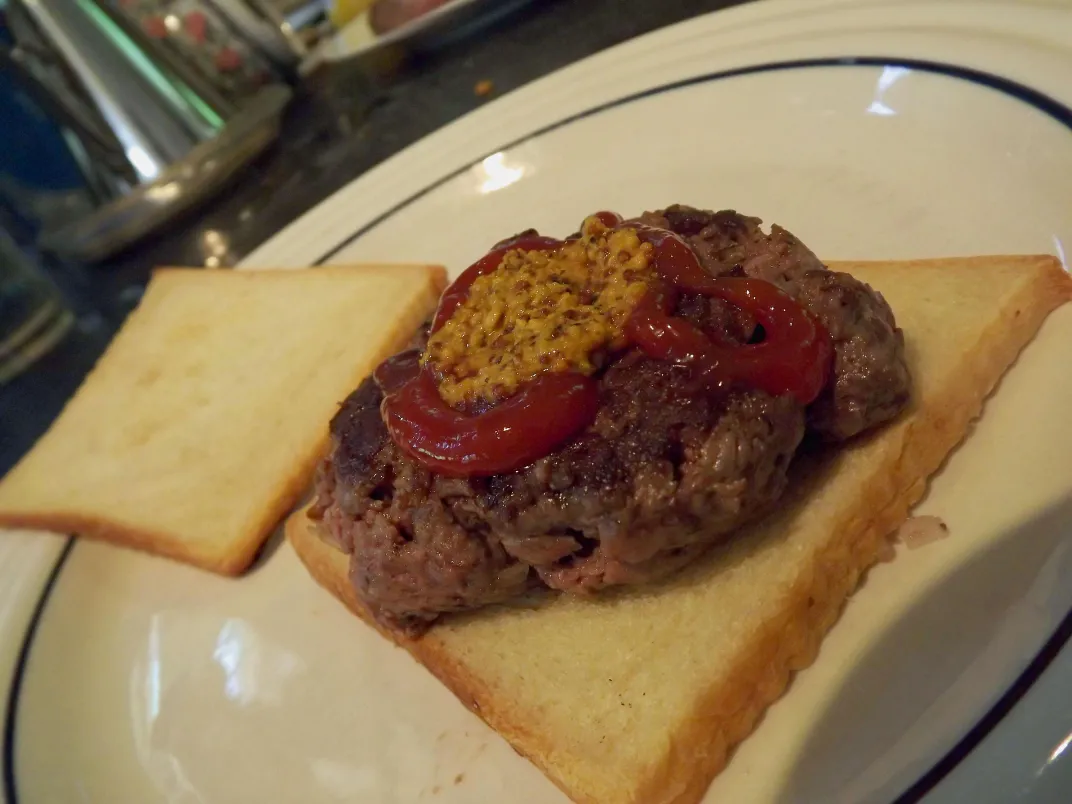Taste-Testing the History of the Hamburger
One intrepid reporter cooked three different versions of the burger to uncover just when, exactly, the sandwich was invented
/https://tf-cmsv2-smithsonianmag-media.s3.amazonaws.com/filer/df/22/df22506a-7aba-407a-8a8b-1d3a33105f2e/groundpistachios.jpg)
Where did the hamburger really come from? The theories vary, with old recipes being discussed and debated far more often than they are eaten. Plenty of historians have argued over whether a recipe from Apicius, a fourth-century Roman cookbook, really constitutes a hamburger. Prevailing wisdom says that the modern hamburger evolved from another ground meat dish called Hamburg steak that made its way from Germany to the United States, where the addition of a bun made it the hamburger of today.
What could be learned by recreating a few of the key dishes in the evolution of the hamburger? I decided to find out.
I teamed up with Leni Sorensen, a culinary historian who specializes in the history of American cuisine. After careful research, we spent a day in her kitchen recreating the history of the burger. Mary Burruss, a friend and fellow writer, served as an additional taste-tester.
The recipe in Apicius seemed like a good place to start. The text was named after a first-century A.D. gourmand, who was almost certainly not its author. Apicius’ origins are unclear, but we know that it was written in a largely colloquial form of Latin and provided various advice and recipes useful for cooking in a wealthy Roman or other Mediterranean household. Several translations into English have been made, based on various somewhat differing copies of the text in Latin. The first translation, published by Joseph Dommers Vehling in the 1800s, is freely available through the Gutenberg Project, and it’s what we used as a reference for our endeavor.
Vehling labeled the dish, “Kromeskis,” borrowing a term for a vaguely similar European dish that he happened to be familiar with. Most of the ingredients listed in the recipe were easy to come by, but a few assumptions had to be made. No definite quantities of any of the ingredients were specified, although standardized units of volume and weight existed in ancient Rome. The recipe calls for nuts but does not specify which type. Pistachios were commonly available in Rome so that was what we used. The recipe also calls for wine without specifying the varietal. The exact varieties of wine grapes grown in the Roman empire have been difficult to trace, and it isn't clear which modern varieties are descended from them, but we do know that wealthy people generally drank white wines and the poor drank reds. As such, we selected a pinot grigio for the recipe.
I chose a beef chuck roast for the Roman burgers, figuring that wealthy Romans may have been able to afford to fatten up their cattle before slaughter. Ideally, I would have liked to use meat from an Italian-heritage breed like the maremmana primitiva.
As the patties sizzled on the pan, they smelled like burgers cooking. Leni, myself and Mary simultaneously took a bite. “It's like a gourmet burger,” said Mary. “It's absolutely a burger. There is no doubt in my mind.”
“The Romans would have had mustard,” Leni pointed out. I slathered my patty with a dollop of her homemade mustard, which only added to the appeal. It looked like a burger, it smelled like a burger, and it tasted like a burger. The only thing missing was the bun.
But there is no clear connection between the burger-like meals of ancient Rome and the modern quarter-pounder. The Roman recipe fell out of use and probably would have been lost if the Apicius text had not been preserved by monks and scholars. Part of the reason for this may be the labor involved in mincing meat manually with a knife. Apicius was intended as a manual for cooking for the wealthy. These recipes would have been prepared by slaves.
“It takes a lot,” said Leni. “I have hand-minced meat before and you have to put out some energy to do it. That's one of the reasons it would have been elite because you would have had to have someone else do it. You, yourself, would not choose to do it.”

Our next stop through hamburger history was Hamburg steak, which is usually described as a patty made of ground beef that is more or less the same thing as the modern interpretation of Salisbury steak. That turned out to be less than the whole truth.
Hamburg steak allegedly originated in the German city of the same name and made the leap to the United States by way of the many ships that made Hamburg their last European port of call before crossing the Atlantic for New York or Boston. German sailors and migrants are purported to have requested the dish at American restaurants.
But the history of Hamburg steak – and hamburgers -- in America has been muddied by several different versions of a fake menu purporting to be from Delmonico's, the famous New York City restaurant, in 1834, 1837 and various other years. As outlined by scholars Jack Prost and Ellen Steinberg, very little about this menu adds up, from the restaurant’s address (cross-referenced with business listings) to the menu items to even the font and typeset used.
Delmonico's was always a high-end restaurant specializing in French cuisine and would have been unlikely to serve Hamburg steak or hamburgers until well into the 20th century. This was a restaurant that offered Dindonneaux Viennoise Aux Champignons, Petits Pois A La Parisienne for two dollars – not pork and beans for four cents.
Aside from a few earlier mentions of “Hamburg steak” that give no indication as to what the dish is, descriptions and recipes in English begin to appear in newspapers and cookbooks starting in the 1870s. The earliest detailed recipe we could track down comes from Mrs. Lincoln's Boston Cookbook, published in 1884 (link is to a later edition). The recipe instructs the reader to:
Pound a slice of round steak enough to break the fibre. Fry two or three onions, minced fine, in butter until slightly browned. Spread the onions over the meat, fold the ends of the meat together, and pound again, to keep the onions in the middle. Broil two or three minutes. Spread with butter, salt and pepper.
“This is quite a well-known cookbook,” said Leni. “Boston was a cosmopolitan city and a chef there would have been aware of new dishes, aware of what people were serving in restaurants around Europe.” The Hamburg steak at that time was pounded – not minced or ground – and it is likely that a prominent Boston cookbook author would have gotten it right.
A shorter description from an 1873 edition of The Lincoln Weekly, a Nebraska newspaper, also gave instructions to “cut or pound round steak to make it tender,” before adding onions.
I began mincing an onion as Leni pounded the meat in accordance with the instructions in the Boston cookbook. “Only use one,” she advised. “Onions were smaller in the 1880s.”
Pounding meat in order to tenderize it takes a lot of work (though it is easier than mincing). It was much more work than running it through a meat grinder. But mechanical grinders were still rare items in the 1880s. A typical kitchen would not have had one when Mrs. Lincoln's Boston Cook Book was first published.

The meat sizzled coming out of the broiler. It looked delicious. It tasted delicious. But it bore no resemblance to a burger.
“It's not a hamburger,” declared Leni. “If you put it on bread, you'd call it a steak sandwich.”
“It's delicious but it's not a hamburger,” Mary concurred.
It was becoming clear to us that the critical step in the evolution of the hamburger was probably the availability of meat grinders. In 1897, a company called Landers, Frary and Clark launched their “universal food chopper. Originally marketed for chopping and grinding almost any food in the kitchen, today we would look at this object and refer to it as a meat grinder. As a culinary historian, Leni just happened to have a vintage model dating back to 1902 for us to use. Other grinders had been available in the previous decade, but the Universal Food Chopper was the first really big hit.
The Sears Roebuck catalog was partially responsible for the spread of the grinder. By 1894, the catalog had expanded to include almost anything that an American farmer, housewife or kid could want. Many of the items were things that readers didn't even know they wanted until they saw it in the Sears catalog. Sears was able to put the universal food chopper in front of millions of people across the United States, along with a simple way of ordering one.
Our next experiment used the exact same ingredients and methods as described in Mrs. Lincoln’s Boston Cookbook, except that we ground the meat using Leni's vintage grinder rather than pounding it. It took astoundingly little effort to crank. In minutes we had the next batch of proto-burgers ready to cook. This time, we shaped the meat into patties.
These were hamburgers. I knew the moment I bit into one. Even without a bun. The ingredients were the same as the authentic Hamburg steak, but running the same meat through a grinder made a world of difference. Steak Hamburg turned into a completely different food once people switched from pounding to grinding.
Most of the claims to the invention of the hamburger fall between 1885 and 1904, which is right around when mechanical meat grinders started to become widely available. They also mostly involve someone putting Hamburg steak between two pieces of bread, usually at a fair, festival or an amusement park. All events where people were walking around and couldn't eat food with a fork and knife. In order to make Hamburg steak quickly in a fairground setting, you would probably want to be working with a meat grinder rather than spending ten minutes pounding a piece of meat for every person standing in line.

Our final step was to simulate those first fairground burgers that seem to have been invented independently across the U.S. The hamburger bun did not exist yet, so we used Leni's freshly baked white sandwich bread, sliced thinly to maximize the number of slices, as any enterprising food vendor might. An oven or broiler would have been more awkward to transport to a fairground than a simple grill or griddle over a fire, so we fried the patties rather than broil them. Both mustard and ketchup were common, and probably would have been available at an American fair in that era, and we allowed ourselves those two condiments and no others.
“I like it on the thin bread better than on most modern hamburger buns,” said Leni between bites.
“The steak Hamburg is definitely not a hamburger,” said Mary. “But then the fairground hamburger is.”
The early fairground hamburger was not exactly like any modern burger that I have ever eaten. But it tasted as much like a real burger as a Model T looks like a real car.
“People like to think that their uncle Joe with his pushcart in Poughkeepsie was the first guy to serve hamburgers,” said Leni. “And he may have been the first guy to serve ground meat between two pieces of bread on his corner in Poughkeepsie, but he's got to share the stage with a lot of other people [who had the same idea.]”
Numerous towns and restaurants ranging from Athens, Texas’ Uncle Fletcher Davis to Louie’s Lunch in New Haven, Connecticut, make claims to inventing the hamburger.
Who is telling the truth? Maybe all of them.

/https://tf-cmsv2-smithsonianmag-media.s3.amazonaws.com/accounts/headshot/JacksonLanders.jpg)
/https://tf-cmsv2-smithsonianmag-media.s3.amazonaws.com/accounts/headshot/JacksonLanders.jpg)